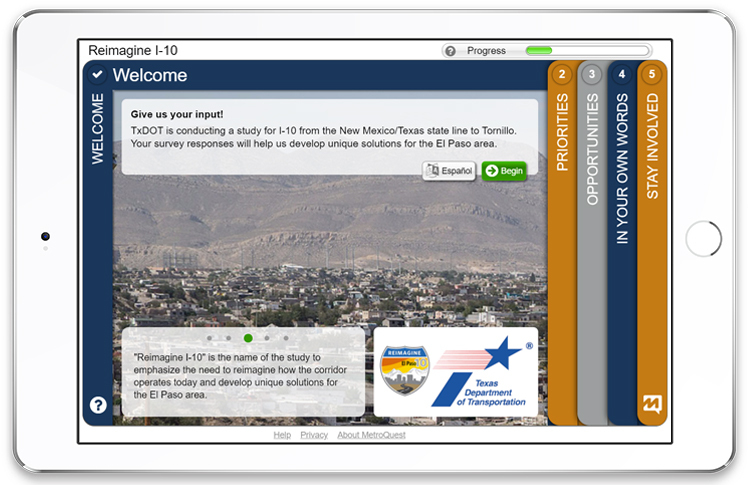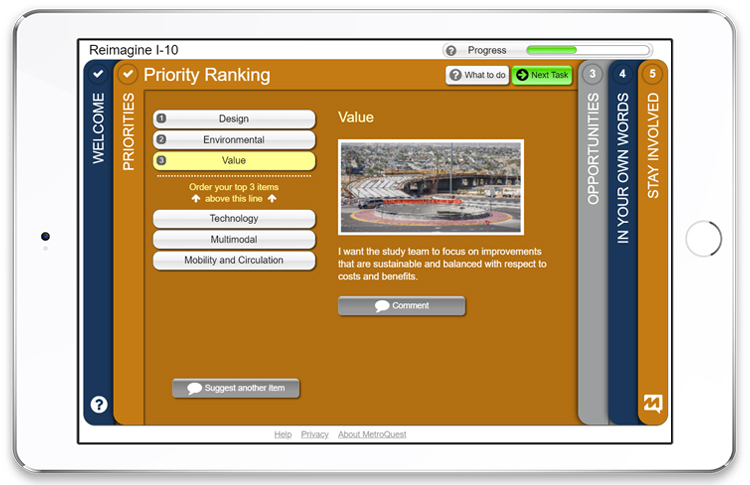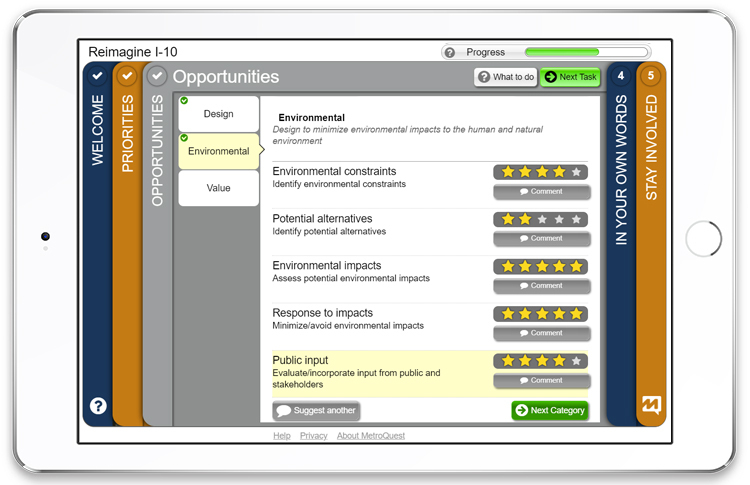[SURVEY OF THE MONTH] Uncovering Future Transportation Needs with Reimagine I-10, TxDOT’s Corridor Feasibility Study
![[SURVEY OF THE MONTH] Uncovering Future Transportation Needs with Reimagine I-10, TxDOT’s Corridor Feasibility Study [SURVEY OF THE MONTH] Uncovering Future Transportation Needs with Reimagine I-10, TxDOT’s Corridor Feasibility Study](https://metroquest.com/wp-content/uploads/SURVEY-OF-THE-MONTH-Uncovering-Future-Transportation-Needs-with-Reimagine-I-10-TxDOT’s-Corridor-Feasibility-Study-e1598045812413.png)
Earlier this summer, we introduced the Survey of the Month blog where we shine the spotlight on a particularly great example of a MetroQuest survey that was created by one of our users. These surveys lend themselves well to highlight take-aways applicable to other users and surveys. Transportation planning has always been on the forefront of MetroQuest customers’ minds, and we are excited to highlight a corridor study survey to inspire you with the fantastic work other agencies and firms have done!
This corridor study was created by the Texas Department of Transportation (TxDOT). The planning study focuses on a segment of the I-10, namely from the Texas-New Mexico border to Tornillo, and uses a MetroQuest survey to inform and survey the public in an engaging way. Read on to learn what they did and what you can take away from their survey!
What’s the story? Understanding Future Transportation Needs of an Important Corridor
TxDOT created the “Reimagine I-10″ survey to kick off an advanced planning study for a part of the I-10, which is the southernmost cross-country highway in the American Interstate Highway System. The highway spans major cities from California, Arizona, and Texas, to New Mexico, Louisiana and Florida. The study was created to analyze and evaluate current and future transportation needs for a specific section of the I-10, the Greater El Paso corridor.
The study area contains five US and Mexican ports of entry and is undergoing significant growth and development yet has limited alternative route options due to its unique geography. This puts additional pressures on an already busy corridor.
Therefore, Reimagine I-10 was created as a feasibility study to find options to relieve pressures on the corridor and look at operational, corridor wide, and technological improvement options. Within each of these three levels of considerations, various solutions were studied.
For more background information, please visit the website.
Anatomy of a Survey: How the Reimagine I-10 Study Makes the Most of MetroQuest’s Capabilities
The Reimagine I-10 MetroQuest survey contains 5 Screens: after introducing the project and providing background information, the survey provides participants with the opportunity to decide what TxDOT should consider when developing potential improvements. They are asked to rank their top three priorities from a randomized list of six, namely Technology, Multimodal, Environmental, Mobility and Circulation, Design and Value. This first activity helps TxDOT understand participants’ priorities and, in addition, sets the stage for the second exercise.
On the follow-up Screen, participants are asked to provide more details on the priorities they chose on the first Screen, and rate strategies associated with each priority on a 1-5 scale. Between three and five strategies are presented for each of the categories previously picked as top priorities. Connecting the two Screens like this gives participants a tailored experience – more on this later!
On the third Screen, participants are asked to describe in their own words how they currently use the I-10 Greater El Paso Corridor, be it for commuting, occasional use or similar. The free form textbox also allows participants to list priorities, concerns, their vision or bring up other items the survey hasn’t covered. In typical fashion, the survey ends with a few demographic questions and a thank you message.
If you’d like to try the survey, click here: https://reimaginei10english-demo.metroquest.com/. This is a demo version that will not affect the survey results.
5 Tips from Reimagine I-10: Using MetroQuest’s Linked Screens to Make a Tailored Experience and Gather Meaningful Data
The Reimagine I-10 survey makes the most of MetroQuest by creating a customized and straight-forward experience. Below are five takeaways from the survey:
- On the Priority Ranking Screen, TxDOT limited the list of possible priorities to six and asked participants to rank just their top three. By limiting the number of priorities that can be selected, they ask that participants really consider what is truly important to them. The lower number also has a second benefit when using connected screens.
- The Priority Ranking Screen is connected to the Strategy Rating Screen, meaning the priorities that a participant identifies as their top choices in the first activity are presented as the categories in the second activity. This gives the participant a tailored experience, as it asks them for additional input on their top three categories. Not only does this give the survey a tailored feel, but it also saves time, gives a more straight-forward experience, and collects more meaningful data.
- On the strategies, TxDOT opted to include a comment button for each of the strategies which is a great opportunity to ask for more input on topics already identified as important to the participant.
- The strategies purposefully have both a title and a short description. Titles allow for an initial level of understanding at a quick glance while longer descriptions go into more detail on items that are interesting to participants.
- The third activity TxDOT chose is the Vision Statement Screen which allows for text input. This Screen is a great choice as it captures ideas and concerns, and the result are put into a useful word cloud in the Data Center. This can be particularly useful at an early stage of a project as it allows for blue sky thinking which may lead to new ideas, strategies, or opportunities.
For more tips on how to make the most out of MetroQuest, contact your Customer Experience manager or reach out for more information!
Want to learn more about how MetroQuest supports your projects to help plan for your community’s transportation future? Check out our recent webinar!
Indianapolis MPO’s Formula for Actionable Public Input on Bike, Ped & Transit
In this webinar, Jen Higginbotham at Indianapolis MPO shares her step-by-step formula for engaging the public in alternative transportation planning using both online engagement and traditional involvement methods!




